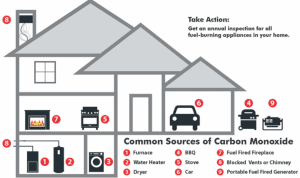Over the festive period it is easy to forget about the dangers of CO (carbon monoxide) positioning. This time of year is when the risk of such poisoning is high due to the colder weather, and people spending more time in doors, and replying on various heating methods.
Over 200 people are hospitalised with CO (carbon monoxide) positioning each year, which leads to around 50 deaths. Since 2014 there has been a 10% rise in recorded incidents of suspected carbon monoxide positioning across the UK.
The silent killer – The carbon monoxide message has never been more important.
New Developments:
CO alarm manufacturers are helping to combat this increase by designing alarms, which incorporate the very latest multi-sensing and connective technology, where alarms in a property can be interlinked. When one alarm is triggered, they are all triggered at the same time.
This can be useful in larger properties, where someone may not hear an alarm in another part of the home. This can give them valuable time to take action and get out of the property. This is also especially useful for the elderly who may not hear an alarm in another room.
Advanced new alarm systems are also able to mimic the sound of the alarm in a property. For example, if a specific sound alerts to a fire, then that specific sound will be heard through all other alarms, giving the occupants an indication whether it’s a fire or CO detection.
Common Sources of Carbon Monoxide:
1. Furnaces
2. Water Heaters
3. Dryers
4. BBQs
5. Stoves
6. Car
7. Gas fires
8. Cookers
9. Central heating systems
Avoiding The Risk – Being Proactive:
Alarms are there to detect when there is a problem. However, being proactive is a much better option. Look for clues that your home maybe at risk:
.
- Look for stains, soot or discolouration on (or around) your boiler, fire or water heater
- Make sure there are no blockages in your chimney or flue
- Keep the air vents in your doors, walls and windows clear
- Check the pilot light on your boiler (and any other gas flames that normally burn blue). If the flame is yellow or orange, you might have a carbon monoxide leak
Owners of Wood Burning Stoves:
As a stove owner, you should avoid burning unseasoned wood, this causes congestion in the flue, which can increase the risks of chimney fires, and also carbon monoxide poisoning. Also ensure you have your chimney swept on a regular basis, for often stove use we would suggest twice a year as a minimum.
Know The Signs of Carbon Monoxide Positioning:
.
- Dull headache
- Weakness
- Dizziness
- Nausea or vomiting
- Shortness of breath
- Confusion
- Blurred vision
- Loss of consciousness
Learn more about our wide range of high efficiency wood burning stoves – more info









